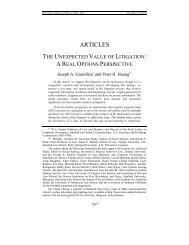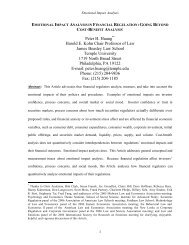Secure Implementation Experiments: Do Strategy-proof Mechanisms ...
Secure Implementation Experiments: Do Strategy-proof Mechanisms ...
Secure Implementation Experiments: Do Strategy-proof Mechanisms ...
Create successful ePaper yourself
Turn your PDF publications into a flip-book with our unique Google optimized e-Paper software.
5.1 Design<br />
We conducted two sessions (one P and one S) at Tokyo Metropolitan University during<br />
June of 1998 and two sessions (one P and one S) at Purdue University during February of 2003.<br />
Each session took approximately one hour to complete.<br />
Treatment P implements the pivotal mechanism for a two-person group. The net true<br />
value vector ( v 1 , v 2 ) is equal to ( −6 , 8 ) if a binary public good is produced and ( v 1 , v 2 ) = ( 00 , )<br />
otherwise. The public good should be produced since v 1 + v 2 ≥ 0. Let the strategy space of type<br />
1 be the set of integers from -22 to 2, and the strategy space of type 2 be the set of integers from -<br />
4 to 20. According to the rules of the pivotal mechanism described in Section 3, we can<br />
construct the payoff matrices of types 1 and 2.<br />
The payoff tables that we actually distributed to subjects in Treatment P were Tables 1<br />
and 2 whose basic structures were the same as the original payoff tables, modified as follows.<br />
First, we changed the names of strategies. Type 1's strategy "-22" was renamed "1", "-21" was<br />
renamed "2", and so on. Similarly, type 2's strategy "-4" was renamed "1", "-3" was renamed "2",<br />
and so on. Second, we employed a linear transformation of the valuation functions: 14 v 1 + 294<br />
for type 1 and 14 v 2 + 182 for type 2.<br />
-------------------------------------------<br />
Link to Table 1 and 2<br />
--------------------------------------------<br />
Table 3 is a payoff matrix with both players’ payoffs displayed: the left-hand number is<br />
type 1’s payoff and the right-hand number is type 2’ payoff in each cell. 9 It also specifies the<br />
dominant strategy equilibria and the other Nash equilibria. Type 1's dominant strategies are 16<br />
and 17, and type 2's dominant strategies are 12 and 13. The two dominant strategies are<br />
equivalent for each type in the sense that her payoffs are identical for every possible strategy<br />
played by the other type; and although payoffs of the other type could be different depending<br />
9 We did not provide this table to any subject. Type 1 subjects used table 1 only and type 2 subjects employed table 2<br />
only.<br />
18
















